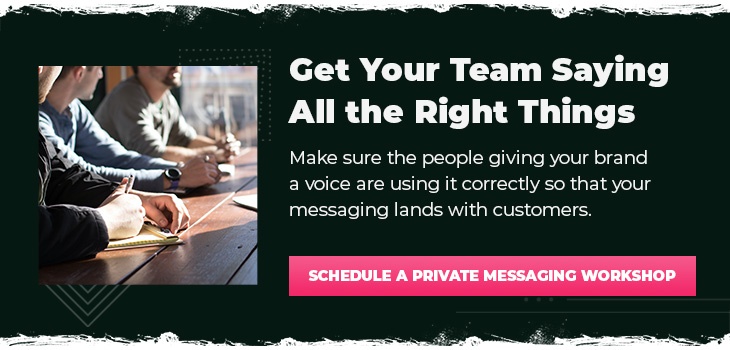Consider these statistics:
- The average website conversion rate for B2B services is 3.5%
- Top websites across all industries convert at 11%
- But the average conversion rate for B2B tech companies is only 1.7%
That’s right, B2B tech companies convert half the number of website visitors as other B2B service businesses. That puts you squarely behind the curve.
So what’s the solution? At some point you may begin to pour money into outbound tactics but right now you need to make a big impact without investing hundreds of hours. To do that, you need to assess the core component of all your marketing efforts: the message you’re communicating.
Check out this case study. One company boosted their conversion rates by 212.74% simply by employing “message match” in their marketing materials across the board.
The takeaway from all these statistics: A well-crafted messaging strategy can boost website conversions.
To address some of the unique challenges the tech industry faces when crafting effective messaging, I brought in Ali Garbero, copywriter and word wizard. She’ll walk us through a few aspects that make the tech industry different from its B2B counterparts and how to craft a messaging strategy that compels prospects and drives more revenue.
Complexity: The Death of Product Messaging
“Your messaging lays the foundation for the way you’re going to communicate across the board,” Ali says. “You need to identify the one key point that you’re about and make sure it’s clearly stated in everything you write for your brand.”
This is especially important for tech companies, whose products are often complex and whose marketers often suffer from the curse of knowledge. Like any industry, tech messaging needs the five elements of an effective messaging strategy — positioning, value proposition, brand promise, target audience and tone of voice.
However, tech companies face specific challenges that get in the way of an effective messaging strategy. Namely, insider language, long sales cycles, intangible features and a constantly evolving landscape.
Insider Language
To many consumers, tech companies speak a foreign language. Your audience isn’t up to speed on all the lingo, so understanding your solution takes a lot of effort and feels intimidating. Prospects might want to buy, but if your copy confuses them, it creates a barrier to a decision.
“Tech companies often use so much insider language because they think highlighting those finer details will set them apart,” Ali explains. “But the real way you set yourself apart is by being clear in your messaging.”
She notes that in the tech industry, a clear message not only differentiates your brand in the marketplace, it also positions you as the company that’s easy to understand and “gets” their customers.
Long Sales Cycles
Engagement is tough to garner. (That’s why there are so many articles about it.) But it’s especially difficult when the sales cycle is long, as it is with most tech products or services.
Because tech solutions typically come with a higher price tag, they require significant buy-in from decision makers and stakeholders. “The problem is that the people reading your materials aren’t always the decision maker,” Ali says. “So you have to create content that allows someone to fully understand your value so they can champion it to their organization.”
Perceived Value of Intangibles
It’s easy to assess the value of tangible products. Is the quality, durability or usefulness of this item worth what I paid for it? With technology, however, the bulk of the value is often in the intangibles — time saved, ease of use, efficiencies — which leaves you with the tall order of creating perceived value around something your clients can’t necessarily hold in their hands.
There’s also the time and cost of implementation to consider. It sometimes takes months to get a customer fully onboarded and using a tech product or service. If they don’t have a clear understanding of the product’s value, any hurdle during this timeframe could trigger buyer’s remorse.
“Keep in mind that, ultimately, people aren’t buying your software,” Ali says. “It’s about what they get from your product. It’s aspirational and inspirational.”
Constantly Evolving Landscape
Finally, there’s the reality that technology is constantly evolving. Think Google Pixel 7, Metaverse or MailChimp’s 2022 updates — there’s always something new around the corner in the tech industry.
The struggle is communicating those changes. Many of these happen on a very technical level, like changes in coding, software developments and other advanced features that customers may or not fully understand.
Ali reminds us that with every new iteration of a product, you have to remind people of the problem and the stakes. “Even if things evolve and change, you’re still solving the same problem. So remind your customers that all these updates come back to providing the best possible solution.”
If you work in the tech industry, you’re probably all too familiar with each of these issues. The good news is that a well-crafted messaging strategy can help to alleviate these pain points and convert more customers.
How to Create a Tech Messaging Strategy
As mentioned earlier, messaging strategies for tech will follow much the same format as for other industries. The key for tech companies is to focus on the four areas that address the problems discussed above:
- Target audience
- Unique selling point
- Brand positioning
- The Customer Journey
Target Audience
Assessing your target audience is pretty standard practice in any marketing exercise, but it’s absolutely critical when crafting a messaging strategy for tech products or services.
“You’re not speaking to your own know-how. You’re trying to communicate with the most people in the shortest amount of time,” Ali explains. “That means speaking in a way that’s relatable to your audience. This makes you feel like a friend; like someone they can trust.”
If your audience doesn’t immediately understand the problem you solve, they aren’t likely to stick around and figure it out. Ali reminds us that people have a lot of demands on their time, so they need to understand quickly so they can qualify or disqualify themselves and move on.
In tech, products and services are often highly specialized, which can make it difficult for a lay person to understand the value. Communicating value often comes down to two things: simplicity and repetition.
Clarify your message so that it’s as simple as it can possibly be and highlights the solution you offer. Look at these examples from tech giants:
- Salesforce: “We bring companies and customers together.”
- HubSpot: “Software, tools, and resources to help your team grow.”
- Mailchimp: “Turn emails into revenue.”
After you’ve clarified your message, you’re going to have to repeat it. A lot. Studies show that consumers have to see a message at least seven times before it actually sticks in their minds.
“You might feel like you’re repeating your message twenty times over, but you have to,” Ali says. “You have to communicate that solution over and over again to ensure that people remember it when it’s time to make a decision.”
Unique Selling Point (USP)
The unique selling point, or value proposition, is a key element in tech messaging. Odds are there are a handful of products or services out there just like yours, so you need to assert what makes you the clear choice over competitors. However, that can seem hard to do when avoiding tech jargon.
Keep in mind that if there are multiple products like yours, people probably know the gist of what you do. “But even if people know what you do, they still don’t know why you’re special,” Ali says.
She offers the example of Delta and Southwest. Two well-known commercial airlines that thousands of people fly every day. But what makes someone choose one over the other? Southwest uses its USP in almost all of its messaging to consistently differentiate itself from the competition: “Bags fly free.” That’s what makes them different and that’s why many people choose to fly with them.
“Instead of focusing on features, ask yourself, ‘Why would I hire my company over the other company?’” Ali suggests. This shifts your mindset to the customer’s point of view and will help you choose a USP that actually matters to them.
Another tactic she recommends is assessing some of the common objections made about your product or service and answering the call in your messaging. For example, maybe you have a SaaS product that requires ample technical support, but customers aren’t getting that from other companies. Your USP could distinguish you as the best in customer service with something like: “24/7 support is one click away.”
Brand Positioning
Is the way you communicate value aligned with how you’ve positioned yourself in the market? Your messaging is a key component of brand positioning. It allows you to establish yourself as a guide and educator and influence the perception of your brand.
Finding the right positioning can be tricky in the tech industry — you need to be authoritative without being condescending and differentiated in a saturated market. Ali suggests considering your customer when deciding how to position your brand.
“You have to paint a picture of what’s on the other side of this decision to buy,” Ali explains. “Show them that they can be a leader who drives their organization forward, creates efficiencies and solves problems. It’s about that aspirational identity more than the product itself.”
She reminds us that the customer journey can be a long process, which is why it’s so crucial to establish yourself as a guide. Position yourself as the brand willing to educate and you’ll build trust with potential customers as they move through their journey. Plus, you’ll give them the information they need to assess if they’re a good fit for your product or service, saving your sales team time and resources on leads that aren’t a match for your business.
“Your positioning isn’t about features and benefits. It’s about how you’ll continually solve problems for your customers,” Ali says.
The Customer Journey
The customer journey is a fundamental part of marketing in any industry. It helps you hone your messaging and tailor your content to exactly what prospects and customers need at an exact point in their relationship with you.
“Ultimately, your customers are on a journey to be the heroes of their story,” Ali explains. “They’re not focused on your company stats. They’re trying to accomplish their own goals and solve their own problems.”
She notes that understanding the needs of your customers throughout their journey is the key to speaking to their pain points and delivering the right message at the right time.
“When you message around what their needs are, you’re going to capture their attention far easier than if you’re just puffing your chest about how great you are,” she says.
With messages that concisely establish your solution, targeted to each stage of the customer journey, you can clearly communicate the transformation that your product or service offers.
These four areas are critical to crafting a messaging strategy that will capture your target audience, educate them about your solution and move them to a conversion point.
Send the Right Message
Messaging is the key to bringing people into your brand and communicating your solution. Without clear messaging, especially in complex industries like tech, customers are likely to walk away without realizing the value you offer.
A messaging strategy helps you create copy that people can quickly understand and act on. If they immediately know your solution, they’re more likely to take the next step. To learn more about how messaging strategies work, check out this blog.









